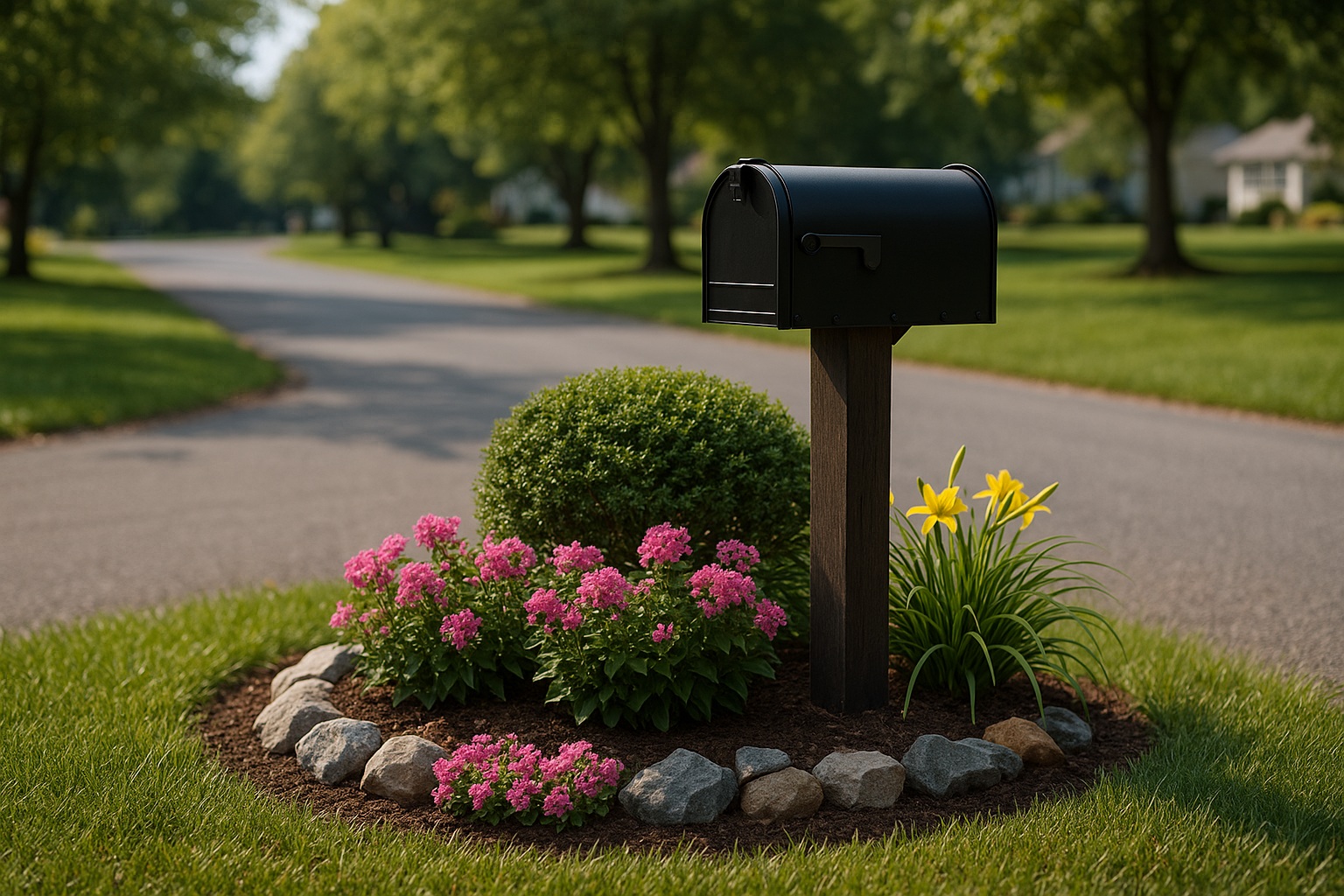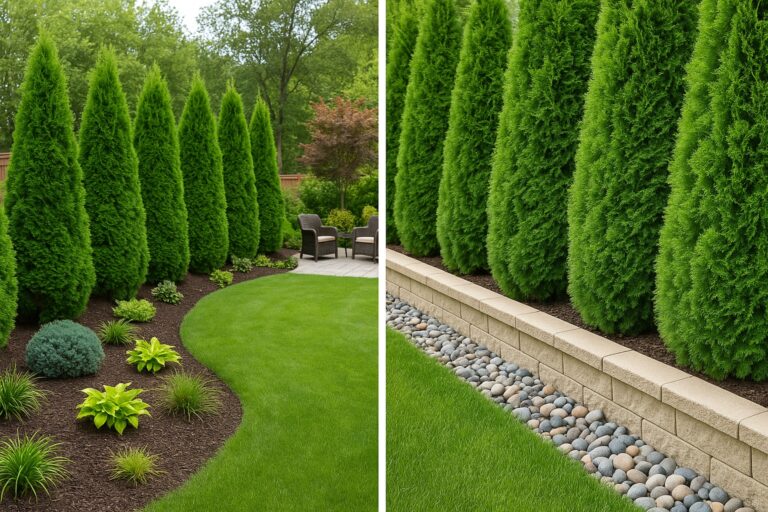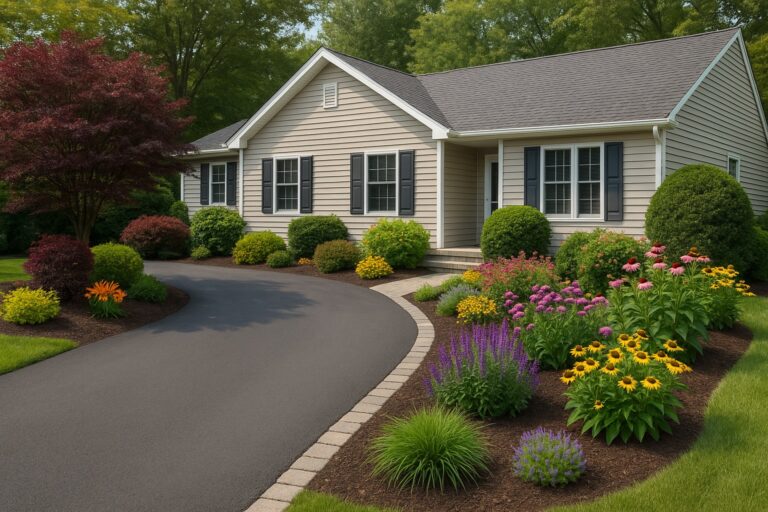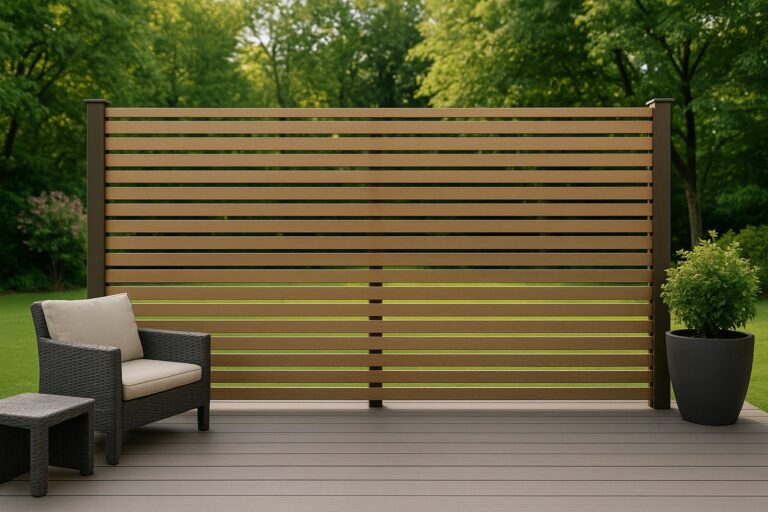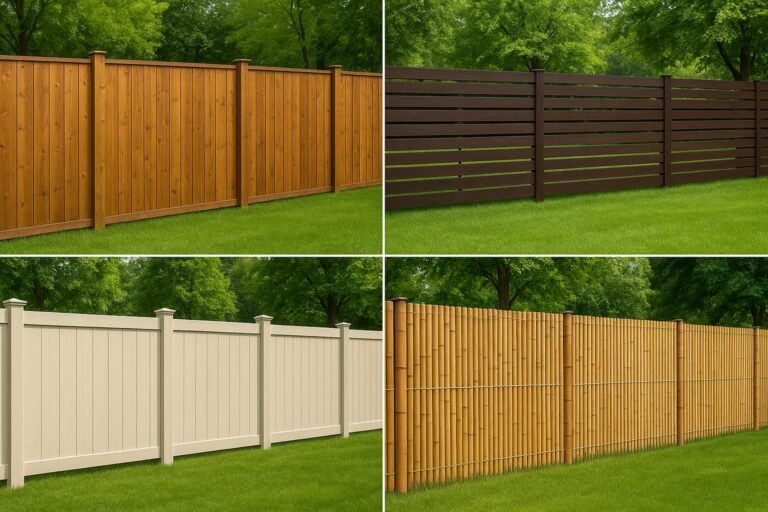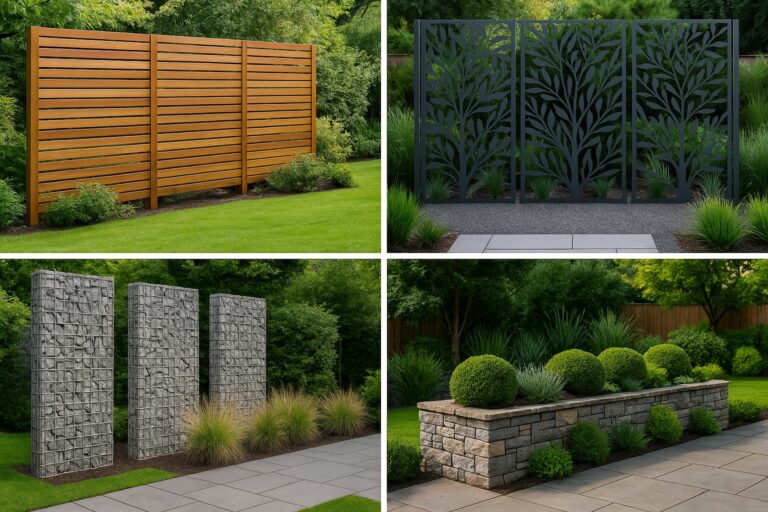Your mailbox is one of the first things people notice from the street, yet it’s often the most neglected part of a front yard. A thoughtful, right-sized planting around the post can transform the look of your home without a full landscape overhaul. The best mailbox landscaping balances structure (edges, anchors, evergreens) with color (seasonal flowers, foliage contrast) and practicality (mower strips, drip lines, sightlines for drivers). It should be tough enough to handle heat radiating off pavement, road splash, and the occasional mis-aimed delivery, while still looking crisp in the off-season. Below are design-forward, maintenance-smart ideas you can mix and match—deliberately avoiding ornamental grasses—to create a handsome mailbox vignette that ties your curb to your front walk and door.
Create a Mini Flower Bed Island
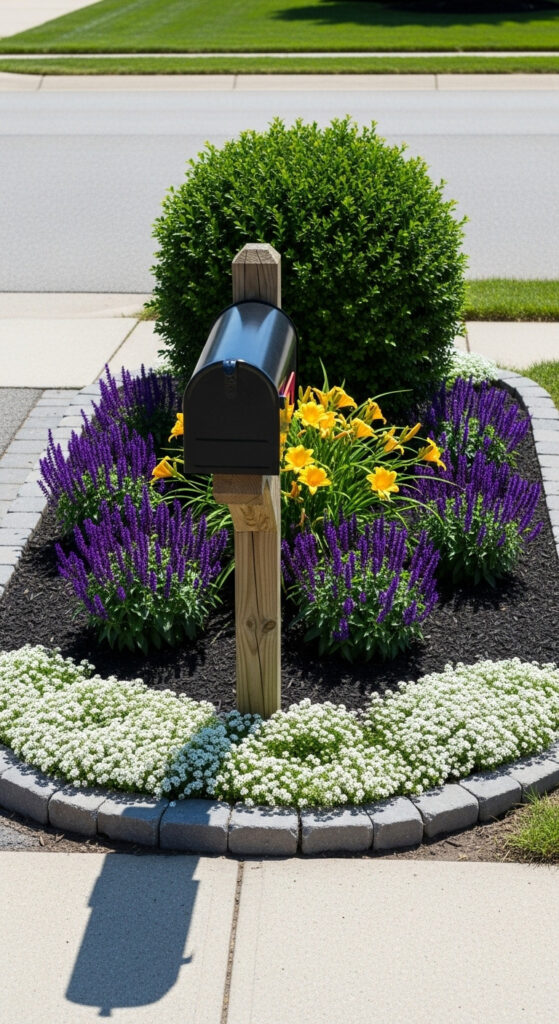
Turn the mailbox into a destination by carving out a compact, layered bed. On most verges, an oval or teardrop bed 3–5 feet wide feels generous without overwhelming the strip. Anchor the rear with a single compact evergreen (boxwood, dwarf holly, or small yew), step forward with mid-height perennials such as coneflower, salvia, or daylilies, and finish the front arc with low edging plants or seasonal annuals. A simple stone or paver border prevents mulch from washing onto the sidewalk and instantly makes the bed look intentional rather than improvised. Keep the door swing clear and leave a small service stone at the back for easy pruning access.
Evergreen Structure for Year-Round Form
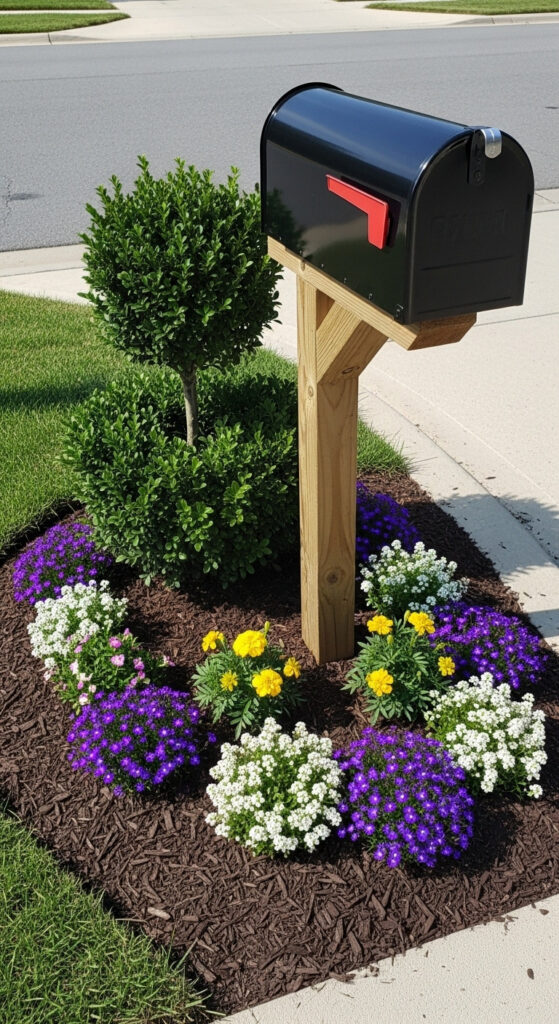
Flowers come and go, but an evergreen keeps the composition standing tall in winter. Choose slow, compact cultivars that shrug off road salt and heat: dwarf boxwood, compact yaupon holly, or little-leaf privet kept clipped. Offset the evergreen slightly behind and to one side of the post to avoid a “target” look; this asymmetry feels designed and allows a different seasonal accent on the opposite side. Mulch well to buffer temperature swings and reduce water needs. A once-or-twice-yearly trim maintains a crisp outline and ensures the shrub never blocks the mailbox door or sightlines for drivers and pedestrians.
Color Palette That Echoes the Front Door
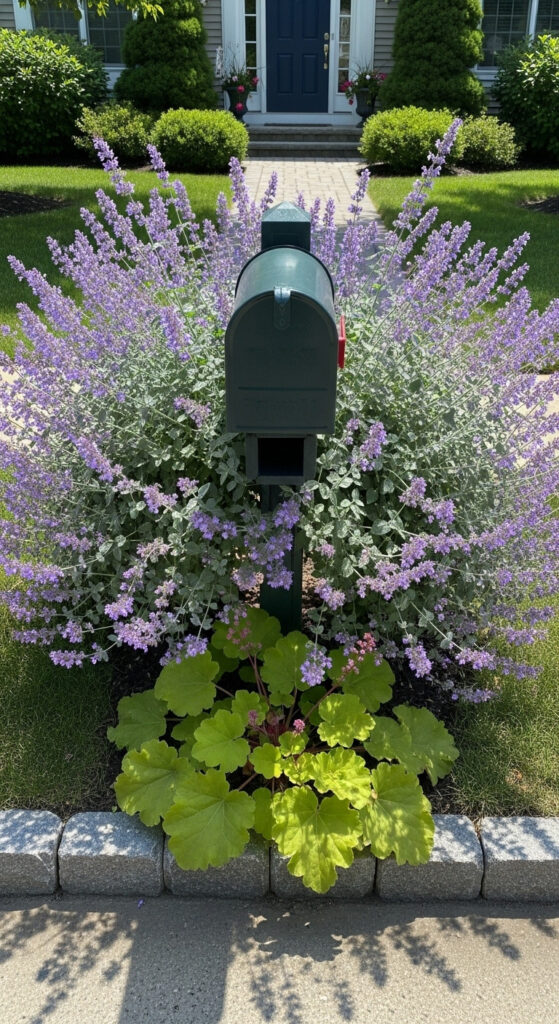
Tie the curb to the house by repeating your front door or shutter color in the planting. A navy door pairs beautifully with blue salvia and silvery catmint; a red door can echo through scarlet geraniums (annuals) or bee balm; a chartreuse door harmonizes with lime-leaf heuchera. Limit the palette to two bloom colors plus green and let foliage texture—broad hosta-like leaves versus fine sedum—carry interest between peak bloom cycles. This small design move makes the mailbox bed feel intentional and connected to the architecture, not random. Repeat the color once more near the walk to lead the eye to your entry.
Clean Rock or Paver Border for Edge Control
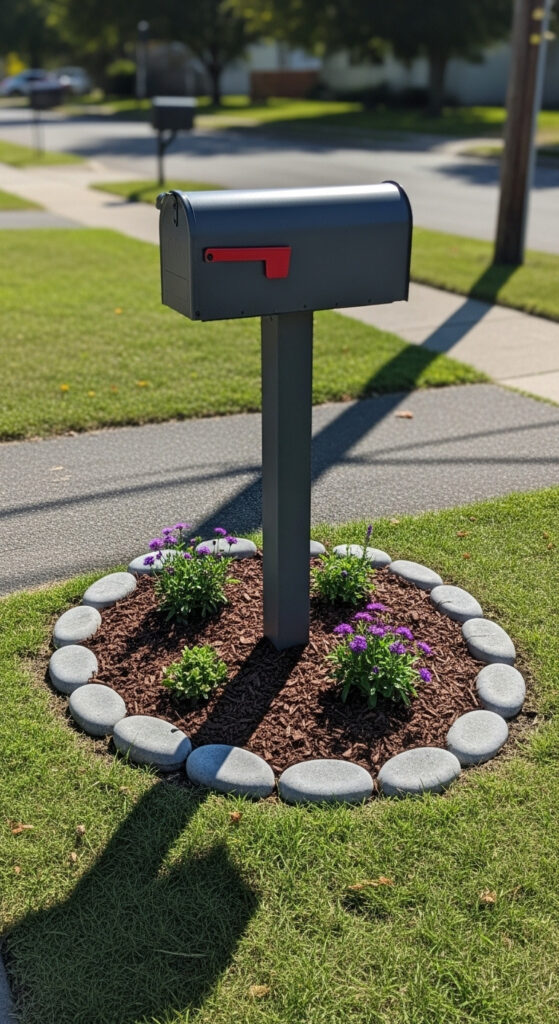
A clean edge is half the battle on a sloped or narrow verge. Dry-stack flat stones or install a soldier course of brick or concrete pavers set flush with the lawn. The border keeps mulch contained, discourages foot traffic, and gives you a durable mowing line. Select a color that coordinates with your home’s masonry or roof tones—cool gray stone for modern palettes, warm buff or red brick for traditional. Keep curves generous so the mower follows easily, and avoid finicky zigzags that trap debris.
Low, Tough Groundcovers at the Curb Edge
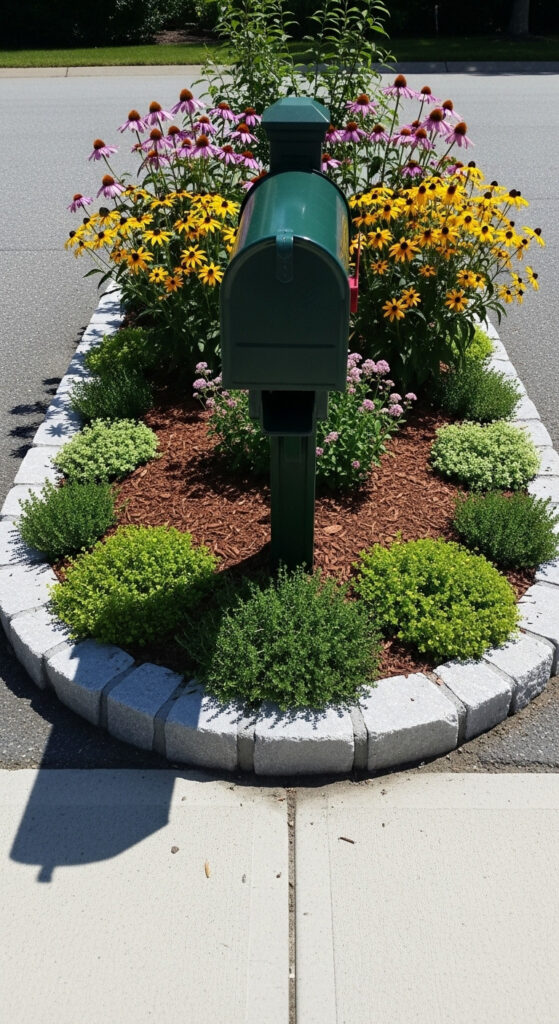
The front lip of a mailbox bed gets roasted by pavement and splashed by rain. Plant resilient, low growers that won’t flop into the street—creeping thyme, sedum, ajuga, dwarf mondo (climate permitting), or even white alyssum for seasonal softness. Tuck them in tightly along the border so they knit a clean carpet, suppress weeds, and keep mulch from migrating onto the sidewalk. Keep taller perennials behind the post; the low front layer ensures postal access stays clear and drivers’ sightlines remain unobstructed.
Trio of Compact Shrubs for Balance
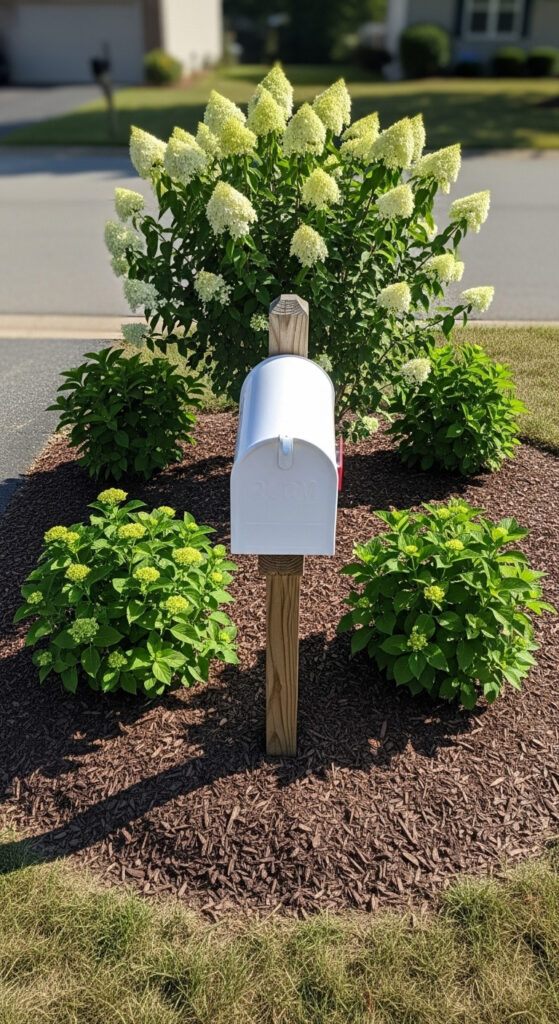
Design likes odd numbers. Plant a trio of small shrubs—think compact hydrangea (‘Bobo’), dwarf spirea, or small barberry (where permitted)—in a triangle around the post. Place one shrub behind and slightly offset from the mailbox, and two staggered toward the street side, leaving pockets for seasonal color. This delivers substance without a hedge and reads as “designed” from a passing car. Verify mature sizes; curb plantings should never require aggressive pruning to avoid the door or road.
Mower-Friendly Paver Apron
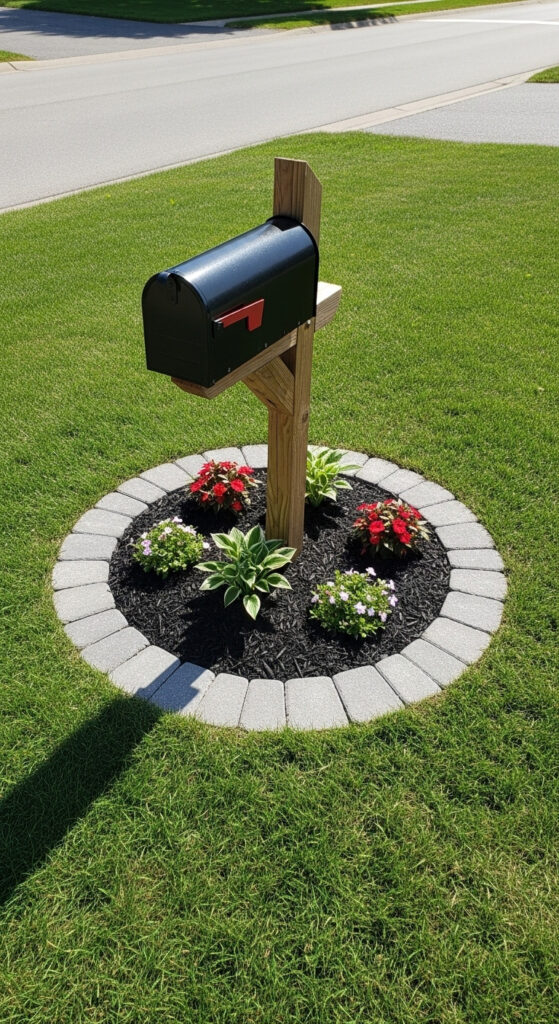
If trimming around the bed is a chore, build a flush paver apron 18–30 inches wide around the planting. The mower can ride the apron and leave a clean cut line without string trimming. This works especially well on tight verges where every inch counts. Choose pavers that match the walkway or driveway to make the composition feel unified. Keep the inner edge smooth and continuous; fewer joints mean less debris and easier sweeping.
Fragrant, Pollinator-Friendly Planting
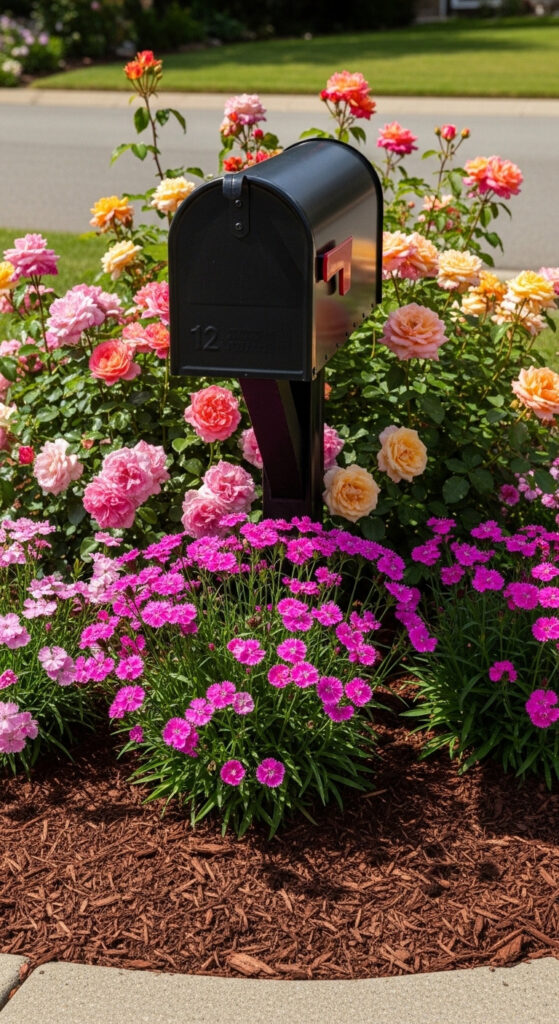
Make checking the mail a sensory moment. Lavender, bee balm, scented dianthus, catmint, and salvia draw bees and butterflies while smelling terrific as you pass. Plant the tallest blooms behind or beside the post so the door opens freely; reserve the front arc for knee-high or lower varieties. Add one nectar shrub—like a compact butterfly bush cultivar if allowed—to extend the season. A restrained palette keeps the bed from reading wild; aim for repetition rather than a collector’s mix.
Shade-Loving Foliage Mix
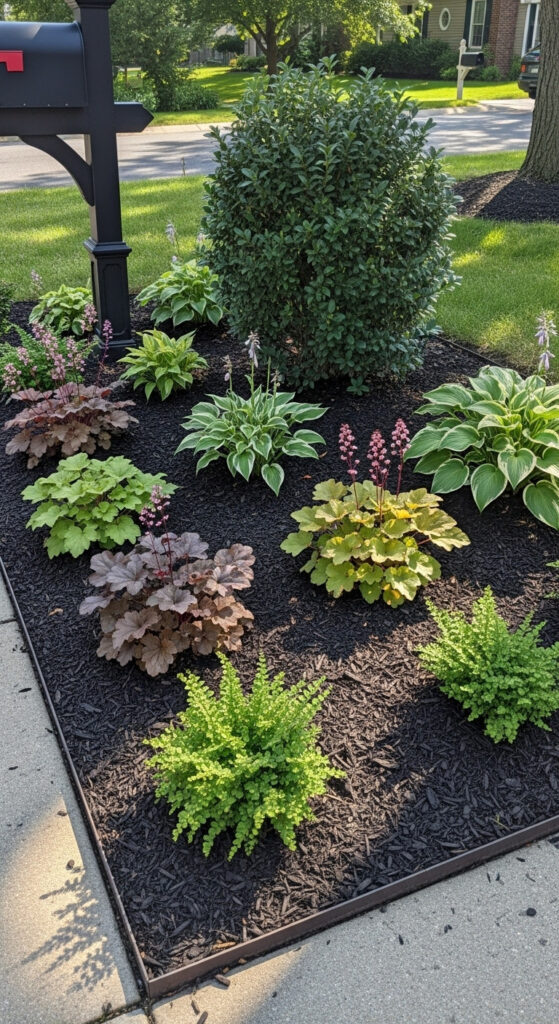
If a street tree casts shade over your mailbox, trade flower power for leaf drama. Combine heuchera (coral bells) for color, small hostas for bold texture, and compact ferns for feathery fill. Anchor with a small evergreen such as a dwarf holly or boxwood. Variegated foliage (brunnera, lamium) adds brightness in lower light. Keep edges crisp with steel or brick edging so leaves don’t creep onto the walk, and add a spring soil refresh to keep the bed looking lush through heat.
Seasonal Bulb Drift for Spring Pop
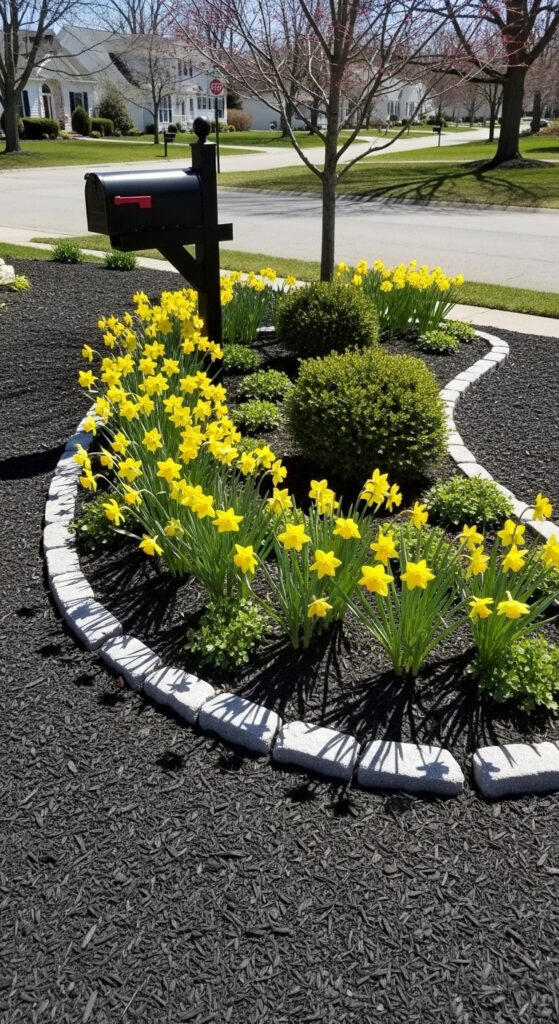
A small drift of bulbs delivers early-season delight with nearly zero maintenance. Tuck daffodils, grape hyacinths, or species tulips between perennials and your evergreen anchor. After flowering, their foliage fades beneath later growth, so the bed never looks bare. Plant in irregular clusters for a natural look and repeat the same variety to avoid polka-dots. Bulbs also help “announce” the bed from a distance during the shoulder season when other plants are just waking up.
Decorative Boulder as a Scaled Anchor
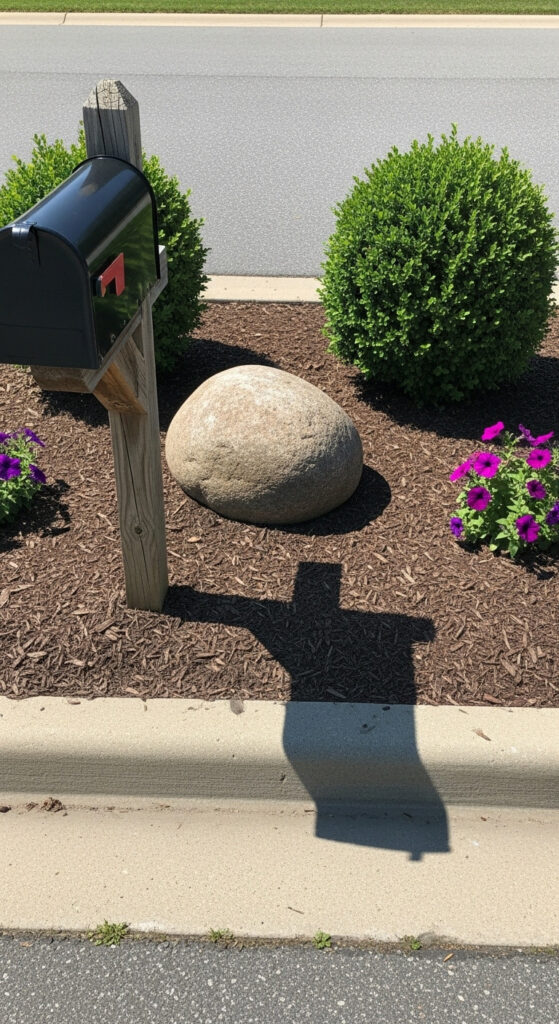
One well-chosen rock grounds the composition and adds four-season structure. Aim for a boulder roughly the size of a carry-on suitcase; set one-third of it below grade so it looks “planted,” not perched. Place it opposite your evergreen for visual balance, and resist the urge to add many small rocks—a single statement stone is more elegant. The boulder can also act as a base for a seasonal pot without expanding the bed.
Upgrade the Post and Box for Cohesion
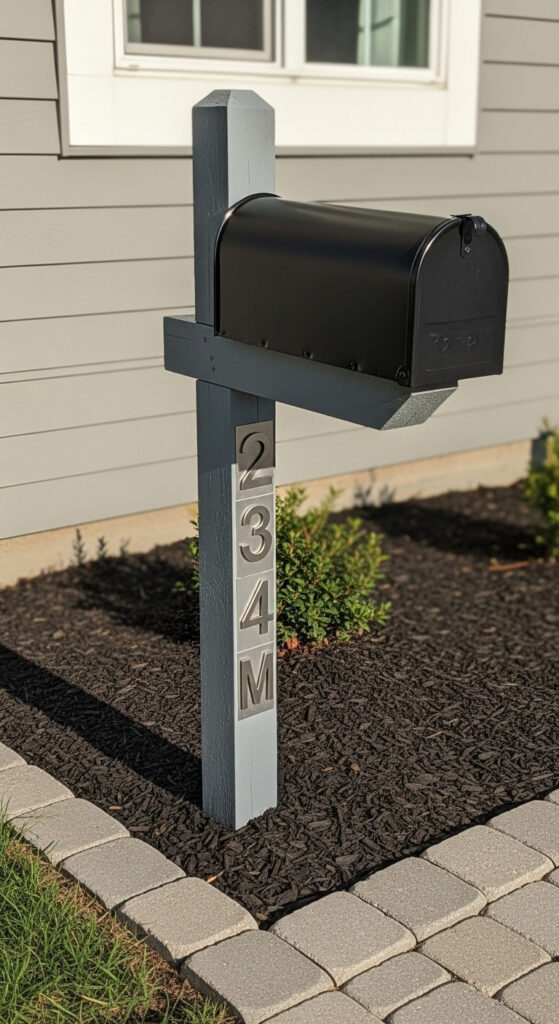
Sometimes the planting is fine but the hardware lets everything down. Replace a leaning 4×4 with a sturdier post painted to match house trim or stained to match the front door. Consider a clean-lined metal box with a tight latch and integrated newspaper shelf. Add a discreet cap or bracket that echoes details on your porch railing. Fresh hardware elevates the whole vignette, making even a modest planting look purposeful.
Subtle House Numbers and Solar Lighting
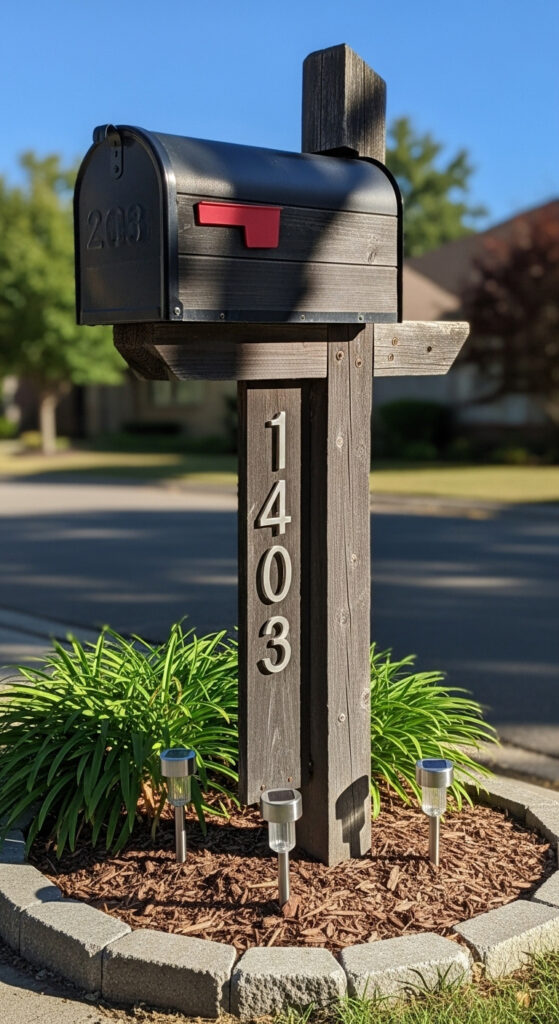
Function can be beautiful. Mount brushed-metal house numbers vertically on the post or set a small plaque within the bed so deliveries land right. Add two or three low, warm-white solar path lights inside the border—far enough from the curb to avoid damage, close enough to gently wash the post at night. Keep fixture styles simple so they disappear by day. Avoid uplights that glare into drivers’ eyes; mailbox lighting should be polite and practical.
Plan for Easy Maintenance From Day One
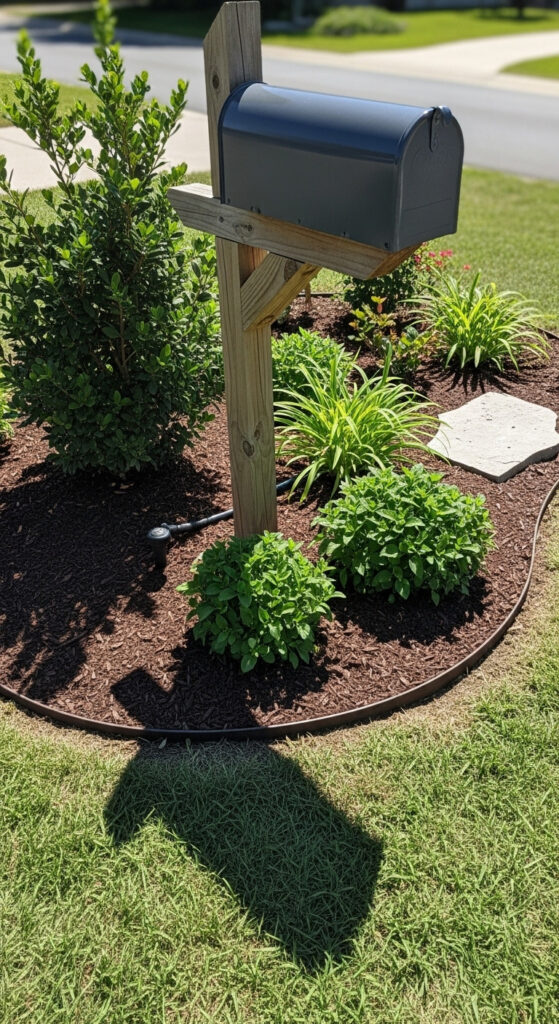
Design for how you’ll care for it. Install a discreet drip ring or short soaker hose loop under mulch and connect it to a simple timer; the bed will stay hydrated through heat waves without hand-watering. Include a stepping stone at the back for pruning access. Choose varieties that top out below the mailbox door and avoid fast spreaders near the curb. A spring routine—edge, top up mulch, light, slow-release fertilizer—keeps the vignette sharp with minimal effort all year.
Meet Tomas Clayton, a seasoned plant gardener who has been passionate about horticulture since he was a child. Tomas John developed a love for the natural world and a strong appreciation for the beauty of plants while growing up on a farm.

